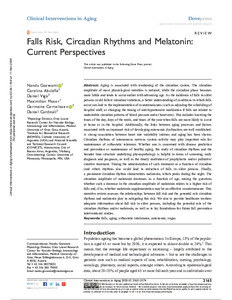Por favor, use este identificador para citar o enlazar este ítem:
https://repositorio.uca.edu.ar/handle/123456789/11547| Título: | Falls risk, circadian rhythms and melatonin : current perspectives | Autor: | Goswami, Nandu Abulafia, Carolina Andrea Vigo, Daniel Eduardo Moser, Maximilian Cornelissen, Germaine Cardinali, Daniel Pedro |
Palabras clave: | ENVEJECIMIENTO; RITMO CIRCADIANO; MELATONINA; FISIOLOGIA; RIESGOS | Fecha de publicación: | 2020 | Editorial: | Dove Medical Press | Cita: | Goswami, N., Abulafia, C. A., Vigo, D. E., Moser, M., Cornelissen, G., Cardinali, D. P. Falls risk, circadian rhythms and melatonin : current perspectives [en línea]. Clinical Interventions in Aging. 2020, 15. Doi: 10.2147/CIA.S283342. Disponible en: https://repositorio.uca.edu.ar/handle/123456789/11547 | Resumen: | Abstract: Aging is associated with weakening of the circadian system. The circadian amplitude of most physiological variables is reduced, while the circadian phase becomes more labile and tends to occur earlier with advancing age. As the incidence of falls in older persons could follow circadian variations, a better understanding of conditions in which falls occur can lead to the implementation of countermeasures (such as adjusting the scheduling of hospital staff, or changing the timing of anti-hypertensive medication if falls are related to undesirable circadian patterns of blood pressure and/or heart rate). This includes knowing the times of the day, days of the week, and times of the year when falls are more likely to occur at home or in the hospital. Additionally, the links between aging processes and factors associated with an increased risk of developing autonomic dysfunction are well established. A strong association between heart rate variability indexes and aging has been shown. Circadian rhythms of autonomous nervous system activity may play important role for maintenance of orthostatic tolerance. Whether one is concerned with disease prediction and prevention or maintenance of healthy aging, the study of circadian rhythms and the broader time structure underlying physiopathology is helpful in terms of screening, early diagnosis and prognosis, as well as the timely institution of prophylactic and/or palliative/ curative treatment. Timing the administration of such treatment as a function of circadian (and other) rhythms also could lead to reduction of falls in older persons. | URI: | https://repositorio.uca.edu.ar/handle/123456789/11547 | ISSN: | 1178-1998 (impreso) 1176-9092 (on line) |
Disciplina: | MEDICINA | DOI: | 10.2147/CIA.S283342 | Derechos: | Acceso abierto | Fuente: | Clinical Interventions in Aging. 2020, 15 |
| Aparece en las colecciones: | Artículos |
Ficheros en este ítem:
| Fichero | Descripción | Tamaño | Formato | |
|---|---|---|---|---|
| falls-risk-circadian-rhythms-melatonin.pdf | 1,36 MB | Adobe PDF |  Visualizar/Abrir |
Visualizaciones de página(s)
112
comprobado en 27-abr-2024
Descarga(s)
151
comprobado en 27-abr-2024
Google ScholarTM
Ver en Google Scholar
Altmetric
Altmetric
Este ítem está sujeto a una Licencia Creative Commons

